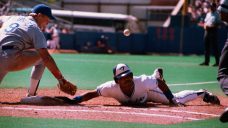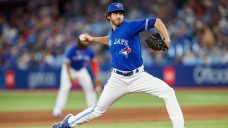TORONTO – Canada’s history at the World Baseball Classic might look very different if injuries hadn’t kept Rich Harden from suiting up with the national team.
The fire-balling right-hander, named for induction to the Canadian Baseball of Fame last week, missed the tournaments in 2006 and '09 due to arm troubles and was too limited by wear-and-tear to take part in 2013.
A healthy Harden could have been a difference-maker on each of those squads and when he looks back on his career, taking the mound with a Maple Leaf on his jersey “is something that I wish I could have done.”
“Growing up very proud to be Canadian, that would probably have been the biggest thing for me, being able to compete for your country,” Harden, now 41, said during a Zoom call following his Hall selection last week. “It's one of those special things I think a lot of Canadians grow up dreaming of. Through everything I've done in my career, having injuries and having my career stopped short, I don't really have any regrets. But the hardest thing is probably not having that opportunity and doing everything to try and make it happen.”
The fifth edition of the Classic is set for next month and the can-he-can’t-he drama inherent to the event’s roster construction is once again a major factor for the Canadian team.
Final rosters are due Tuesday and among the key questions for Canada is the status of Tyler O’Neill, the star St. Louis Cardinals outfielder who wants to play, has club support but must work through insurance issues.
The 27-year-old from Burnaby, B.C., reinjured his left hamstring last September and missed the wild-card series against the Philadelphia Phillies, although he appeared in an Arizona Fall League game in preparation for a division series return had the Cards advanced. That creates some doubt about whether the tournament’s insurer will cover him, potentially pushing him to the sidelines with fellow slugger Josh Naylor, right-handers Mike Soroka and Jameson Taillon, and likely Joey Votto.
Losing O’Neill would further isolate first baseman Freddie Freeman in a Canadian lineup shifting from formidable to pesky. The plan was for O’Neill to play centre field and in his absence, Oakland Athletics prospect Denzel Clarke and former Detroit Tigers outfielder Jacob Robson could share duties there, likely flanked by Jared Young and on-the-rise Minnesota Twins prospect Edouard Julien, who will get at-bats somewhere on the field or at DH.
Freeman is expected to anchor both the lineup and the infield, with Abraham Toro at second, Otto Lopez at shortstop, Charles Leblanc at third base and Bo Naylor (Josh’s younger brother) at catcher.
Barring a surprise, starters Cal Quantrill and Nick Pivetta and relievers Matt Brash and Rob Zastryzni should front the pitching staff. Veterans John Axford and Phillippe Aumont have likely made enough progress to be on the team while Adam Loewen and Andrew Albers were still pushing themselves to be ready.
Cubs reliever Rowan Wick joined Zach Pop in passing on the Classic to focus on competing for a roster spot, while Toronto Blue Jays all-star closer Jordan Romano, who had planned to pitch for Italy again before pulling out, also turned down the Canadians, although he’ll consider doing it next time.
While every country loses out on good players for the Classic, Canada doesn’t have the depth of talent to compensate like the United States, Dominican Republic or Japan.
One good outing from Harden might have been enough to push Canada through to the second round in each of the 2006, 2009 and 2013 tournaments and all the national team can do is hope that their 2023 absences won’t leave them with a similar lament.
TIEDEMANN’S TIME
Among the lasting effects of Alek Manoah’s rapid ascent to stardom is the way his progression may end up altering the development path for other top pitching prospects in the Blue Jays system.
To that end, the trajectory of Ricky Tiedemann, the electric-armed lefty whose star rose so much during a breakout 2022 that he enters the new year as the club’s consensus top prospect, very much bears watching.
The 20-year-old finished last season at double-A, received a non-roster invite to big-league camp and could find himself generating the type of conversations about his timeline this spring that Manoah did in Dunedin back in 2021.
“I’ve gotten asked about that comparison a lot,” said Joe Sclafani, the Blue Jays' director of player development. “They're definitely distinct cases, but Ricky's putting himself in a position to be there for people to start bringing that up and have those conversations. We hope he goes out and dominates this year. We're excited for him to be able to pitch in front of the big-league staff (at spring training). He's an outstanding kid and deserves the opportunity. One thing you know, he'll put in the work to put himself in that position and he gets all the credit for that.”
What makes the two distinct cases is that Manoah, now 25, had three full seasons at West Virginia under his belt along with time at the alternate training site in 2020 before making his big-league debut in 2021 after only nine minor-league appearances. Tiedemann, meanwhile, has just one pro ball season with 78.2 innings under his belt after the pandemic disrupted his high-school and junior college experiences.
Workload management is an imperfect science at the best of times but how many innings Tiedemann can reasonably haul in 2023 will be monitored closely all year.
“We don't like to put arbitrary innings limits on anyone, he's going to dictate where that's at,” says Sclafani. “But we've also got to keep it in the back of our minds that he needs to be able pitch through the end of September and maybe put himself in a position where he's into October and helping the big-league team win. … It's kind of hard to find a ton of stuff to put on him (in terms of developmental goals). He just needs to keep doing what he's been doing and stay on that track.”
A THOUGHT EACH FROM CANADIAN HALL’S INCOMING CLASS
Joining Harden in the Canadian Baseball Hall of Fame’s Class of 2023 are Denis Boucher, the former Montreal Expos lefty who is a longtime national team pitching coach and New York Yankees scout; longtime Blue Jays outfielder Jesse Barfield and veteran Manitoba coach and executive Joe Wiwchar. They’ll be inducted June 17 along with former Blue Jays first baseman John Olerud and broadcaster Jacques Doucet, members of the 2020 class whose introduction was delayed by the pandemic. A thought from each:
Harden, on breaking in with the Athletics at 21 after only 64 minor-league outings and being one of 14 pitchers in the majors 21 or younger during that 2003 season: “It was really quick for that time and there weren't as many kids that age being called up. That's what the A's were we're doing with (Tim) Hudson, (Barry) Zito, (Mark) Mulder and all those guys and it worked out really well for them. I really had no expectations when I signed. … I really didn't know much when I came up. I didn't really have the best command. I hadn't figured that out. Threw hard. Had some decent off-speed pitches but putting it all together took me some years to really learn that. Stepping into that rotation with those guys, you pick things up through talking to them, watching them and also through your own experiences. Looking back, there are so many things I wish I would have known. The way things are now with how important recovery time is and sleep and overtraining and all that. I look at myself at that time and I was just all-in, max effort, training hard and throwing hard. As I got older, I figured out, OK, we've got to pace ourselves, I've got to be able to recover for that next game. Unfortunately, I figured that out when I hurt my shoulder. I wish I had known more but you figured things out through your experiences and that's the way it worked out.”
Boucher on the transition from player to coach: “It wasn't planned at all. Didn't really think through what I was going to do after my career. But started coaching one year, one thing led to another, we qualified for the Olympics (in 2004), we go to the Olympics, that's pretty cool, I'll do it again the following tournament and that was just great. Then when the Expos left Montreal, the Nationals asked me to start scouting for them and now I'm and with the Yankees and I've been doing that for over 20 years now. … I still get to put a uniform on, to get on the field as a coach and go watch ballgames all the time, just be around baseball and around the game. I keep seeing old friends and it's just great to be a part of it and doing that for a living.”
Barfield on joining George Bell (2013) and Lloyd Moseby (2018) in St. Marys, Ont.: “I knew it eventually would come. I don't worry about how I got there and how long it took – we're there, and that's the main thing. The guys that are there now deserve to be there. And I knew eventually I would have a chance to get in, and it worked out great.”
Wiwchar on the origins of his love for baseball and the state of Manitoba baseball: “It's a passion I have. It's something that I just thoroughly enjoy. … The biggest registration number for Manitoba Baseball was when the Blue Jays won the World Series. Our small community in (Morden) of 7,000-plus people is probably the baseball area of Manitoba. We have around 400 kids registered in baseball so that's pretty good.”
Olerud on how he might have adapted his sweet swing and approach in the launch-angle era: “That's a good question. I was joking with Jeff Cirillo, he lives near me and he said, 'You know, John, I don't know if we would have gotten a chance to play not hitting the deep fly ball, the home-run ball and hitting the ball to all fields.’ I think we'd still approach it the same way. Rarely did anybody put a shift on me because that would help me hit the ball the other way. I think most hitters would say that when they're struggling to get hits, if they just force themselves to hit the ball the other way, that helps with their timing and helps get them back on track. I feel like that if a team's putting a shift on, if guys were trying to hit the ball the other way, it would actually help them. I don't know about all the analytics and that kind of stuff that goes into it, but I was somebody that wanted to get hits and home runs were a by-product of a good swing and making good contact. Anytime I tried to manufacture a home run, I was in trouble. I don't think it would change anything for me. I'd still be trying to hit the ball where they weren't, get my hits and get people on base because as the pitchers know, having guys on base gives them one more thing to think about. It's a lot easier to throw out of the windup than it is out of the stretch and there's more pressure with guys on base.”








COMMENTS
When submitting content, please abide by our submission guidelines, and avoid posting profanity, personal attacks or harassment. Should you violate our submissions guidelines, we reserve the right to remove your comments and block your account. Sportsnet reserves the right to close a story’s comment section at any time.